Mushrooms
Media

Species Types
Scientific Name
Morchella angusticeps (formerly M. elata)
Description
The black morel is a prized edible mushroom. It has a honeycombed cap with black to brownish black ridges and yellowish brown pits. It is completely hollow and grows in the spring.
Media

Species Types
Scientific Name
Agaricus campestris
Description
The meadow mushroom has a smooth white to light grayish cap and pinkish brown gills. It's found in lawns and other grassy areas.
Media

Species Types
Scientific Name
Amanita onusta
Description
The onusta amanita has a grayish white cap with grayish brown warts that are often erect, and a long stalk with grayish brown warts. It grows on the ground in mixed woods.
Media
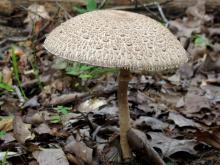
Species Types
Scientific Name
Macrolepiota procera (Lepiota procera)
Description
The parasol is very tall, with a cap that is buff to brown, broad, scaly, with a knob in center; there is a moveable ring on stalk. It grows scattered on the ground, along trails, in open woods, and in old pastures.
Media
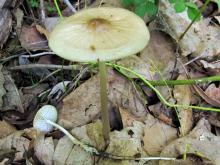
Species Types
Scientific Name
Xerula furfuracea (Collybia radicata var. furfuracea)
Description
The rooted collybia has a moist, wrinkled, grayish brown flat cap and a long, slender stalk that continues underground. It grows singly or scattered on and around deciduous trees and stumps.
Media
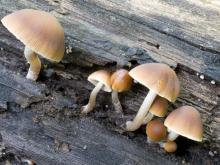
Species Types
Scientific Name
Various species of confusingly similar mushrooms
Description
Like the LGBs (“little gray birds”) of the birdwatchers, this is a catchall category. It includes all the small to medium-sized, hard-to-identify brownish mushroom with spores of all colors. There are many hundreds of species that fit this description!
Media
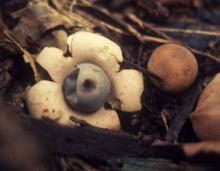
Species Types
Scientific Name
Geastrum species
Description
An earthstar is a roundish ball in the center of starlike rays. It grows on the ground in open woods.
Media
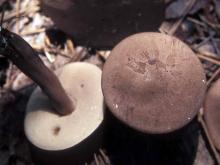
Species Types
Scientific Name
Tylopilus plumbeoviolaceus
Description
The violet-gray bolete has a large, violet-gray cap with cream-pink pores, and a violet stalk that is sometimes webbed. It grows scattered on the ground in mixed woods.
Media

Species Types
Scientific Name
Grifola frondosa
Description
Looking like a ruffled chicken, the edible hen of the woods mushroom grows like large circular bouquet of spoon-shaped caps, each grayish brown on top and white beneath, emerging from a branching, whitish base. It grows on the ground at the base of oak trees.
Media

Species Types
Scientific Name
Meripilus sumstinei (formerly M. giganteus)
Description
The black-staining polypore grows in large, circular clusters of many fleshy, grayish yellow, fan-shaped caps, which bruise black when cut or touched. It grows on the ground around deciduous trees, especially oaks.
See Also



Media

Species Types
Scientific Name
Monotropa hypopitys
Description
Pinesap is a plant that puts the "wild" in wildflower! It lacks chlorophyll, so its roots connect to fungi underground and absorb nutrients from the fungi.
Media

Species Types
Scientific Name
Cladophora, Pithophora, and Spirogyra spp., and others
Description
Filamentous green algae forms green, cottony masses that are free-floating or attached to rocks, debris, or other plants.
Media

Species Types
Scientific Name
Monotropa uniflora
Description
Indian pipe lacks chlorophyll, so it is white, not green. Below ground, its roots join with fungi that connect to tree roots. This plant, then, takes nourishment indirectly from the trees.
About Mushrooms in Missouri
Mushrooms are a lot like plants, but they lack chlorophyll and have to take nutrients from other materials. Mushrooms are neither plants nor animals. They are in a different kingdom — the fungi. Fungi include the familiar mushroom-forming species, plus the yeasts, molds, smuts, and rusts.
Always be cautious when eating edible mushrooms. Be absolutely sure of the ID, and only eat a small amount the first time you try it to avoid a reaction..





















